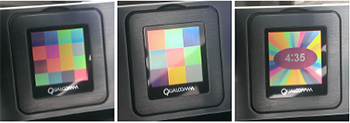
SMI panel demonstrations using light from a fluorescent-lit office environment. Credit: Optica, 0.1364/optica.99.09999
Traditional color displays—from smartphones to sports arena jumbotrons—require power-zapping internal light sources. A team of engineers at Qualcomm MEMS Technologies (USA) may have found a way to replace the emissive technology with a more energy-efficient design that uses reflected ambient light to create brilliant color displays (Optica, doi: 10.1364/optica.99.09999). Their single-mirror interferometric (SMI) display comprises a mirror and a metal absorbing layer separated by a variable gap controlled by a MEMS actuator. The Qualcomm engineers say that the SMI display could offer energy-efficient, continuous color displays with high-quality viewing, even in bright outdoor environments.
Traditional RGB displays create different colors by illuminating one of three subpixels—red, green or blue. The subpixel design reduces the amount of light emitted by each pixel by two thirds because only one subpixel is used at a time. The color gamut is also limited to combinations of red, green and blue.
The SMI design reported in the new research uses interferometric absorption to create a broad spectrum of bright colors. Ambient light passes through the metal absorbing layer to the mirror, where it is reflected back on itself. The incoming light and reflected light interfere with each other in the gap and produce standing waves. The gap between the absorbing layer and the mirror is adjusted with tiny electrostatic actuators to match a node in the standing waves that corresponds to a specific color.
Since nearly the full spectrum of visible light can be reflected by the mirror, the SMI display offers more colors than the traditional RGB display—including high-contrast black and white. The SMI display is also brighter because the entire pixel, not just one third, reflects colored light.
The engineers, led by John Hong, tested their SMI display design with a proof-of-concept panel 1.5 inches across containing about 149,000 pixels. They say the biggest energy savings would come from using the SMI display to retain a static image, where the screen operates in a virtually power-free mode. The electrostatic actuators, absorbing layer and mirror can be fabricated in one piece using the same processes used to create liquid crystal displays. The Qualcomm team plans to improve the SMI design so that it can be integrated into existing manufacturing processes.
